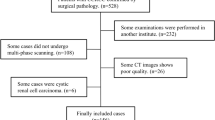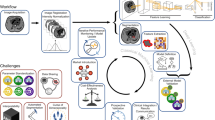Abstract
Purpose
Differentiating renal tumours into grades and tumour subtype from medical imaging is important for patient management; however, there is an element of subjectivity when performed qualitatively. Quantitative analysis such as radiomics may provide a more objective approach. The purpose of this article is to systematically review the literature on computed tomography (CT) radiomics for grading and differentiating renal tumour subtypes. An educational perspective will also be provided.
Methods
The Preferred Reporting Items for Systematic Reviews and Meta-Analyses checklist was followed. PubMed, Scopus and Web of Science were searched for relevant articles. The quality of each study was assessed using the Radiomic Quality Score (RQS).
Results
13 studies were found. The main outcomes were prediction of pathological grade and differentiating between renal tumour types, measured as area under the curve (AUC) for either the receiver operator curve or precision recall curve. Features extracted to predict pathological grade or tumour subtype included shape, intensity, texture and wavelet (a type of higher order feature). Four studies differentiated between low-grade and high-grade clear cell renal cell cancer (RCC) with good performance (AUC = 0.82–0.978). One other study differentiated low- and high-grade chromophobe with AUC = 0.84. Finally, eight studies used radiomics to differentiate between tumour types such as clear cell RCC, fat-poor angiomyolipoma, papillary RCC, chromophobe RCC and renal oncocytoma with high levels of performance (AUC 0.82–0.96).
Conclusion
Renal tumours can be pathologically classified using CT-based radiomics with good performance. The main radiomic feature used for tumour differentiation was texture. Fuhrman was the most common pathologic grading system used in the reviewed studies. Renal tumour grading studies should be extended beyond clear cell RCC and chromophobe RCC. Further research with larger prospective studies, performed in the clinical setting, across multiple institutions would help with clinical translation to the radiologist’s workstation.



Similar content being viewed by others
References
Gillies RJ, Kinahan PE, Hricak H (2016) Radiomics: Images Are More than Pictures, They Are Data. Radiology 278 (2):563-577. https://doi.org/10.1148/radiol.2015151169
Shu J, Wen D, Xi Y, Xia Y, Cai Z, Xu W, Meng X, Liu B, Yin H (2019) Clear cell renal cell carcinoma: Machine learning-based computed tomography radiomics analysis for the prediction of WHO/ISUP grade. European journal of radiology 121:108738. https://doi.org/10.1016/j.ejrad.2019.108738
Sun X, Liu L, Xu K, Li W, Huo Z, Liu H, Shen T, Pan F, Jiang Y, Zhang M (2019) Prediction of ISUP grading of clear cell renal cell carcinoma using support vector machine model based on CT images. Medicine 98 (14):e15022. https://doi.org/10.1097/md.0000000000015022
Yang G, Gong A, Nie P, Yan L, Miao W, Zhao Y, Wu J, Cui J, Jia Y, Wang Z (2019) Contrast-Enhanced CT Texture Analysis for Distinguishing Fat-Poor Renal Angiomyolipoma From Chromophobe Renal Cell Carcinoma. Molecular imaging 18:1536012119883161. https://doi.org/10.1177/1536012119883161
Zhang GM, Shi B, Xue HD, Ganeshan B, Sun H, Jin ZY (2019) Can quantitative CT texture analysis be used to differentiate subtypes of renal cell carcinoma? Clinical radiology 74 (4):287-294. https://doi.org/10.1016/j.crad.2018.11.009
Soffer S, Ben-Cohen A, Shimon O, Amitai MM, Greenspan H, Klang E (2019) Convolutional neural networks for radiologic images: a radiologist’s guide. Radiology 290 (3):590-606
Kumar V, Gu Y, Basu S, Berglund A, Eschrich SA, Schabath MB, Forster K, Aerts HJ, Dekker A, Fenstermacher D (2012) Radiomics: the process and the challenges. Magnetic resonance imaging 30 (9):1234-1248
Lao J, Chen Y, Li Z-C, Li Q, Zhang J, Liu J, Zhai G (2017) A deep learning-based radiomics model for prediction of survival in glioblastoma multiforme. Scientific reports 7 (1):1-8
Shaikhina T, Lowe D, Daga S, Briggs D, Higgins R, Khovanova NJBSP, Control (2019) Decision tree and random forest models for outcome prediction in antibody incompatible kidney transplantation. 52:456-462
Che D, Liu Q, Rasheed K, Tao X (2011) Decision tree and ensemble learning algorithms with their applications in bioinformatics. In: Software tools and algorithms for biological systems. Springer, pp 191–199
Bray F, Ferlay J, Soerjomataram I, Siegel RL, Torre LA, Jemal A (2018) Global cancer statistics 2018: GLOBOCAN estimates of incidence and mortality worldwide for 36 cancers in 185 countries. CA: a cancer journal for clinicians 68 (6):394–424
Deng Y, Soule E, Samuel A, Shah S, Cui E, Asare-Sawiri M, Sundaram C, Lall C, Sandrasegaran K (2019) CT texture analysis in the differentiation of major renal cell carcinoma subtypes and correlation with Fuhrman grade. European radiology 29 (12):6922-6929. https://doi.org/10.1007/s00330-019-06260-2
He X, Zhang H, Zhang T, Han F, Song B (2019) Predictive models composed by radiomic features extracted from multi-detector computed tomography images for predicting low- and high- grade clear cell renal cell carcinoma: A STARD-compliant article. Medicine 98 (2):e13957. https://doi.org/10.1097/md.0000000000013957
Meng F, Li X, Zhou G, Wang Y (2017) Fuhrman grade classification of clear-cell renal cell carcinoma using computed tomography image analysis. Journal of Medical Imaging and Health Informatics 7 (7):1671-1676. https://doi.org/10.1166/jmihi.2017.2184
Sung CK, Kim SH, Woo S, Moon MH, Kim SY, Kim SH, Cho JY (2016) Angiomyolipoma with minimal fat: differentiation of morphological and enhancement features from renal cell carcinoma at CT imaging. Acta radiologica (Stockholm, Sweden : 1987) 57 (9):1114–1122. https://doi.org/10.1177/0284185115618547
Yu H, Scalera J, Khalid M, Touret AS, Bloch N, Li B, Qureshi MM, Soto JA, Anderson SW (2017) Texture analysis as a radiomic marker for differentiating renal tumors. Abdominal radiology (New York) 42 (10):2470-2478. https://doi.org/10.1007/s00261-017-1144-1
Badri AV, Waingankar N, Edwards K, Kutikov A, Parsons RB, Chen DY, Smaldone MC, Viterbo R, Greenberg RE, Uzzo RG (2019) Non-contrast imaging characteristics of papillary renal cell carcinoma: implications for diagnosis and subtyping. Canadian Journal of Urology 26 (5):9916-9921
Guðmundsson E, Hellborg H, Lundstam S, Erikson S, Ljungberg B (2011) Metastatic Potential in Renal Cell Carcinomas ≤7 cm: Swedish Kidney Cancer Quality Register Data. European Urology 60 (5):975-982. https://doi.org/10.1007/s00261-017-1144-1
McInnes MDF, Moher D, Thombs BD, McGrath TA, Bossuyt PM, and the P-DTAG (2018) Preferred Reporting Items for a Systematic Review and Meta-analysis of Diagnostic Test Accuracy Studies: The PRISMA-DTA Statement. JAMA 319 (4):388-396. https://doi.org/10.1001/jama.2017.19163
Collins GS, Reitsma JB, Altman DG, Moons KG (2015) Transparent Reporting of a multivariable prediction model for Individual Prognosis Or Diagnosis (TRIPOD). Annals of internal medicine 162 (10):735-736. https://doi.org/10.7326/l15-5093-2
Schieda N, Lim RS, Krishna S, McInnes MDF, Flood TA, Thornhill RE (2018) Diagnostic Accuracy of Unenhanced CT Analysis to Differentiate Low-Grade From High-Grade Chromophobe Renal Cell Carcinoma. AJR American journal of roentgenology 210 (5):1079-1087. https://doi.org/10.2214/ajr.17.18874
Bektas CT, Kocak B, Yardimci AH, Turkcanoglu MH, Yucetas U, Koca SB, Erdim C, Kilickesmez O (2019) Clear Cell Renal Cell Carcinoma: Machine Learning-Based Quantitative Computed Tomography Texture Analysis for Prediction of Fuhrman Nuclear Grade. European radiology 29 (3):1153-1163. https://doi.org/10.1007/s00330-018-5698-2
Li Y, Huang X, Xia Y, Long L (2019) Value of radiomics in differential diagnosis of chromophobe renal cell carcinoma and renal oncocytoma. Abdominal radiology (New York). https://doi.org/10.1007/s00261-019-02269-9
Yang R, Wu J, Sun L, Lai S, Xu Y, Liu X, Ma Y, Zhen X (2020) Radiomics of small renal masses on multiphasic CT: accuracy of machine learning–based classification models for the differentiation of renal cell carcinoma and angiomyolipoma without visible fat. European radiology 30 (2):1254-1263. https://doi.org/10.1007/s00330-019-06384-5doi:
Lin F, Cui EM, Lei Y, Luo LP (2019) CT-based machine learning model to predict the Fuhrman nuclear grade of clear cell renal cell carcinoma. Abdominal radiology (New York) 44 (7):2528-2534. https://doi.org/10.1007/s00261-019-01992-7
Sun XY, Feng QX, Xu X, Zhang J, Zhu FP, Yang YH, Zhang YD (2020) Radiologic-Radiomic Machine Learning Models for Differentiation of Benign and Malignant Solid Renal Masses: Comparison With Expert-Level Radiologists. AJR American journal of roentgenology 214 (1):W44-w54. https://doi.org/10.2214/ajr.19.21617
Ma Y, Cao F, Xu X, Ma W (2020) Can whole-tumor radiomics-based CT analysis better differentiate fat-poor angiomyolipoma from clear cell renal cell caricinoma: compared with conventional CT analysis? Abdominal radiology (New York) 45 (8):2500-2507. https://doi.org/10.1007/s00261-020-02414-9
Erdim C, Yardimci AH, Bektas CT, Kocak B, Koca SB, Demir H, Kilickesmez O (2020) Prediction of Benign and Malignant Solid Renal Masses: Machine Learning-Based CT Texture Analysis. Academic radiology. https://doi.org/10.1016/j.acra.2019.12.015
Cui EM, Lin F, Li Q, Li RG, Chen XM, Liu ZS, Long WS (2019) Differentiation of renal angiomyolipoma without visible fat from renal cell carcinoma by machine learning based on whole-tumor computed tomography texture features. Acta radiologica (Stockholm, Sweden : 1987) 60 (11):1543–1552. https://doi.org/10.1177/0284185119830282
Feng ZC, Rong PF, Cao P, Zhou QY, Zhu WW, Yan ZM, Liu QY, Wang W (2018) Machine learning-based quantitative texture analysis of CT images of small renal masses: Differentiation of angiomyolipoma without visible fat from renal cell carcinoma. European radiology 28 (4):1625-1633. https://doi.org/10.1007/s00330-017-5118-z
Sharma N, Aggarwal LM (2010) Automated medical image segmentation techniques. J Med Phys 35 (1):3-14. https://doi.org/10.4103/0971-6203.58777
Heller N, Sathianathen N, Kalapara A, Walczak E, Moore K, Kaluzniak H, Rosenberg J, Blake P, Rengel Z, Oestreich M (2019) The kits19 challenge data: 300 kidney tumor cases with clinical context, ct semantic segmentations, and surgical outcomes. arXiv preprint arXiv:190400445
Ronneberger O, Fischer P, Brox T U-net: Convolutional networks for biomedical image segmentation. In: International Conference on Medical image computing and computer-assisted intervention, 2015. Springer, pp 234–241
Paner GP, Amin MB, Alvarado-Cabrero I, Young AN, Stricker HJ, Moch H, Lyles RH (2010) A novel tumor grading scheme for chromophobe renal cell carcinoma: prognostic utility and comparison with Fuhrman nuclear grade. The American journal of surgical pathology 34 (9):1233-1240. https://doi.org/10.1097/PAS.0b013e3181e96f2a
Samaratunga H, Gianduzzo T, Delahunt B (2014) The ISUP system of staging, grading and classification of renal cell neoplasia. Journal of kidney cancer and VHL 1 (3):26
Lambin P, Leijenaar RTH, Deist TM, Peerlings J, de Jong EEC, van Timmeren J, Sanduleanu S, Larue R, Even AJG, Jochems A, van Wijk Y, Woodruff H, van Soest J, Lustberg T, Roelofs E, van Elmpt W, Dekker A, Mottaghy FM, Wildberger JE, Walsh S (2017) Radiomics: the bridge between medical imaging and personalized medicine. Nature reviews Clinical oncology 14 (12):749-762. https://doi.org/10.1038/nrclinonc.2017.141
Cui EM, Lin F, Li Q, Li RG, Chen XM, Liu ZS, Long WS (2019) Differentiation of renal angiomyolipoma without visible fat from renal cell carcinoma by machine learning based on whole-tumor computed tomography texture features. Acta Radiologica 60 (11):1543-1552. https://doi.org/10.1177/0284185119830282
Huang Y, Liu Z, He L, Chen X, Pan D, Ma Z, Liang C, Tian J, Liang C (2016) Radiomics signature: a potential biomarker for the prediction of disease-free survival in early-stage (I or II) non—small cell lung cancer. Radiology 281 (3):947-957
Song J, Liu Z, Zhong W, Huang Y, Ma Z, Dong D, Liang C, Tian J (2016) Non-small cell lung cancer: quantitative phenotypic analysis of CT images as a potential marker of prognosis. Scientific reports 6:38282
Fried DV, Tucker SL, Zhou S, Liao Z, Mawlawi O, Ibbott G, Court LE (2014) Prognostic value and reproducibility of pretreatment CT texture features in stage III non-small cell lung cancer. International Journal of Radiation Oncology* Biology* Physics 90 (4):834-842
Coroller TP, Agrawal V, Huynh E, Narayan V, Lee SW, Mak RH, Aerts HJ (2017) Radiomic-based pathological response prediction from primary tumors and lymph nodes in NSCLC. Journal of Thoracic Oncology 12 (3):467-476
Author information
Authors and Affiliations
Corresponding author
Additional information
Publisher's Note
Springer Nature remains neutral with regard to jurisdictional claims in published maps and institutional affiliations.
Rights and permissions
About this article
Cite this article
Bhandari, A., Ibrahim, M., Sharma, C. et al. CT-based radiomics for differentiating renal tumours: a systematic review. Abdom Radiol 46, 2052–2063 (2021). https://doi.org/10.1007/s00261-020-02832-9
Received:
Revised:
Accepted:
Published:
Issue Date:
DOI: https://doi.org/10.1007/s00261-020-02832-9




